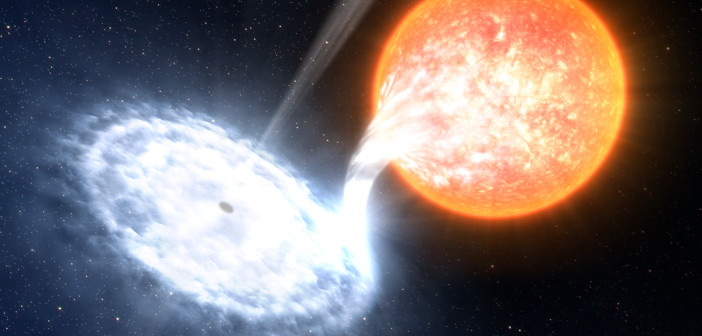In June of this year, after nearly three decades of sleep, the black hole V404 Cygni woke up and began grumbling. Scientists across the globe scrambled to observe the sudden flaring activity coming from this previously peaceful black hole. And now we’re getting the first descriptions of what we’ve learned from V404 Cyg’s awakening!
Sudden Outburst
V404 Cyg is a black hole of roughly nine solar masses, and it’s in a binary system with a low-mass star. The black hole pulls a stream of gas from the star, which then spirals in around the black hole, forming an accretion disk. Sometimes the material simply accumulates in the disk — but every two or three decades, the build-up of gas suddenly rushes toward the black hole as if a dam were bursting.
The sudden accretion in these events causes outbursts of activity from the black hole, its flaring easily visible to us. The last time V404 Cyg exhibited such activity was in 1989, and it’s been rather quiet since then. Our telescopes are of course much more powerful and sensitive now, nearly three decades later — so when the black hole woke up and began flaring in June, scientists were delighted at the chance to observe it.
![The high variability of V404 Cyg is evident in this example set of spectra, where time increases from the bottom panel to the top. [King et al. 2015]](https://aasnova.org/wp-content/uploads/2015/11/fig26-260x721.jpg)
The high variability of V404 Cyg is evident in this example set of spectra, where time increases from the bottom panel to the top. [King et al. 2015]
Windy Disk
The primary surprise from V404 Cyg is its winds. Many stellar-mass black holes have outflows of mass, either in the form of directed jets emitted from their centers, or in the form of high-energy winds isotropically emitted from their accretion disks. But V404 Cyg’s winds — which the authors measure to be moving at a whopping ~4,000 km/s — appear to originate from much further out in the disk than what’s typical. Furthermore, the presence of disk winds and jets is normally anti-correlated, yet in V404 Cyg, both are active at the same time.
King and collaborators believe that the winds are likely associated with the disruption of the outer accretion disk due to pressure from the radiation in the central region as it becomes very luminous. V404 Cyg’s behavior is actually more similar to that of some supermassive black holes than to most stellar-mass black holes, which is extremely intriguing.
The authors are currently working to complete a more detailed analysis of the spectra and build a model of the processes occurring in this awakening black hole, but these initial results demonstrate that V404 Cyg has some interesting things to teach us.
Citation
Ashley L. King et al 2015 ApJ 813 L37. doi:10.1088/2041-8205/813/2/L37


1 Comment
Pingback: the BH in V404 Cygni acts up